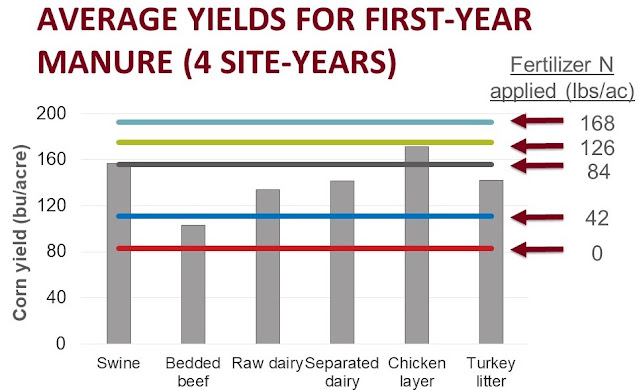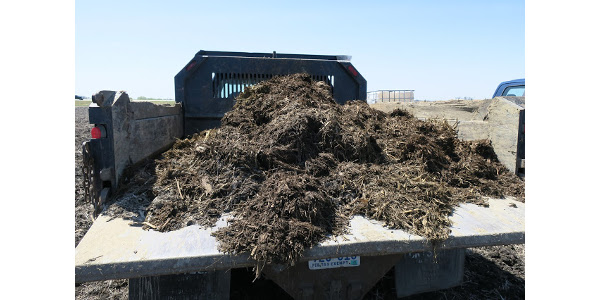Key takeaway from study so far is that the amount of bedding in the manure matters
MINNEAPOLIS — For Minnesota farmers who apply manure, it can be difficult to know how much nitrogen (N) is in the manure they’re applying and when it is available to the crop. This makes it hard to make decisions about how much additional N fertilizer to apply. An ongoing study by the University of Minnesota is studying six different types of manure over several years in an effort to update the university’s manure guidelines.
One of the key takeaways from the study so far is that the amount of bedding in the manure matters.
“If you are applying dairy or beef manure with bedding, then you should probably be aware that the nitrogen release is going to be slower,” said Melissa Wilson, U of M Extension manure management specialist and lead researcher on the project.
The six types of manure being studied are bedded beef pack, swine finishing manure, raw dairy manure, liquid separated dairy manure, composted chicken layer manure, and turkey litter.

The researchers had each of the manure sources analyzed and applied them in the spring on corn-after-soybean plots at the U of M recommended rate (140 lbs N/acre). Then they compared them to plots where they applied N fertilizer ranging from zero to 120% of the full university-recommended rate.“That way we could compare what the nitrogen uptake in the corn was for the manures versus what it looked like for the fertilizers, which is more of a known quantity, to get a good estimate of what the fertilizer equivalent of the manure was,” Wilson explained.
No manure was applied in year two or three of the study in order to see how much nitrogen carried over from the first (application) year. The research plots are in two locations, Lamberton is southwest Minnesota and Waseca in the south-central part of the state. In 2018, the first year of the study, they applied manure at both locations. In 2019, they monitored N credits for those plots and also added another trial at each location. So, this year will be year three for the trials started in 2018 and year two for the trials that began in 2019.
The study is funded by Minnesota’s fertilizer check-off dollars through the Agricultural Fertilizer Research and Education Council (AFREC).
Study results so far
Overall, first year yields were lower than expected and there wasn’t much N carryover into year two for some of the manures. This may have been due to the wet conditions during the first two years of the study.
“For pretty much every manure source at both sites, we were not getting as much nitrogen released as we expected,” Wilson observed.
Unlike N fertilizer, the N in manure is in two different forms, the organic form and the inorganic (plant-available) form. The organic portion has to mineralize first to become plant-available. 2018 and 2019 were very wet years in Lamberton and Waseca compared to historical averages, which could have hindered mineralization.
“The microbes that would normally be doing that couldn’t survive in those conditions as readily as in a normal-to-dry year,” said Wilson. “If this is correct, then the N may still be in the soil. It will be interesting to see what happens this year.”
Averaged across all four year one sites, the composted chicken layer manure provided the most N, followed by the swine finishing manure, the turkey litter, the raw dairy manure, and the liquid separated dairy manure. The bedded beef pack performed the worst of all of the sources. This data is preliminary as the study has not been published yet.

Percentage N available in year one ranged from 58% for the chicken litter to just 8% for the bedded beef pack. This compares to an assumed N availability ranging from 75% for swine finishing manure to 55% for the two dairy sources.
Despite the low N availability for several of the manure sources in 2018, there didn’t seem to be much left for the crop in 2019. Most of the sources were close to the zero N fertilizer equivalent. The bedded beef pack and the chicken litter did have some N carry over to year two. The beef provided around 25 lbs N/acre and the chicken around 20 lbs N/acre.
Bedding matters
In year one, the researchers used aerial images to spot differences in the strips from above. Yellow corn was easy to see in the zero N fertilizer strips and, unfortunately, the bedded beef pack strips didn’t look much better.

“The bedded beef pack did not release nearly as much nitrogen as we expected,” said Wilson. They were expecting about 60% nitrogen availability in the first year but only saw 8-15%. “We think some of that had to do with the bedding.”
Because the beef manure included a grass bedding in year one and corn stalks in year two, Wilson believes these organic materials tied up some of the N in the manure.
“When you start adding bedding that might have a high carbon content, like hay or corn stalk cobs, for dairy and beef manure especially, that definitely seems to change the nitrogen release,” she said.
While the bedded beef pack had less N release the first year compared to the other manures, it had the highest second-year release. This suggests that the N was tied up in the organic form in year one and then released a bit more the second year.
However, there may have been other issues as well. Bedding in manure may make it more difficult to obtain an accurate manure analysis.
“When you send manure with bedding material in it, it’s a little harder to analyze and get a consistent analysis because you could get too much bedding or you could get too little bedding in the actual sample,” said Wilson.
For example, the analysis for the bedded beef pack said that the carbon-to-nitrogen ratio was 15-to-1, which is very low and would suggest that N tie-up is unlikely to happen. But study results show that N immobilization was an issue with the bedded beef pack because not very much N was released in the first year and some carried over to year two.
Wilson isn’t sure if they’re going to do a fourth year for the study since there wasn’t much N left over from manure in year two. They will look at the third year N credits and decide if a fourth year is necessary. In future studies, she would like to look more specifically at the dairy and beef sources because they were more variable than the other sources in the study. By more closely studying the differences between liquid and bedded pack manure sources, she hopes to better understand how bedding affects N.
Despite potential issues with manure analysis in the study, Wilson recommends that growers get their manure tested before application rather than rely on published book nutrient values.
“While there is still variability in the results you get when you test manure, it is lower than relying on book values,” she said.
Soil health
While bedding may complicate N management planning, Wilson is quick to note that these manure sources have long-term soil health benefits due to their high carbon content.
“Anytime you’re adding carbon, it’s going to benefit soil health because that’s food for the soil microbes,” she explained.
There’s even some evidence that manure application can help with infiltration.
“If it’s going to be a wet year, you want your water to soak in faster than, rather than sit on the surface,” Wilson added.
Farm-to-farm variability
Manure varies a lot from farm to farm, especially when bedding is involved. For example, the turkey litter the researchers used the first year was “fresh out of the barn” and released a similar amount of N to the top-performing chicken litter. However, the turkey litter the next year, which they received from the same farm as the first year, had been sitting longer and didn’t release as much N.
“As the pile ages, you would expect some of the active nitrogen to be removed through rain and gaseous losses,” said Wilson. “When you have a more aged product, you have a lot less of the immediately plant-available stuff.”
Current university recommendations assume that the ratio of available N to organic N is the same regardless of the amount of bedding. That could change after this study.
“I’m hoping that adjusting based on how much is in the organic fraction versus how much is in that ammonia fraction will help fine-tune that a little bit more, because I’m thinking that what a lot of these storage practices are really impacting is that ratio,” said Wilson.
She sees the university guidelines as a good starting point for most farmers.
“They are averages and you will see differences between years and even within facilities but we still have to start somewhere, and that’s what these recommendations do,” she added. “Over time, if farmers feel they’re getting more or less nitrogen release than our guidelines, then they can adjust.”
Because of the variability of N availability in manure sources, Wilson thinks it might be a good idea to apply a baseline of manure, possibly 70-80% of your full N needs, and then come back with a sidedress N fertilizer application during the growing season if needed.
“This might be a better way of managing your manure risks and mitigating some of these risks with the variability.”
—
For the latest nutrient management information, subscribe to Minnesota Crop News email alerts, like UMN Extension Nutrient Management on Facebook, follow us on Twitter, and visit our website.
Support for Minnesota Crop News nutrient management blog posts is provided in part by the Agricultural Fertilizer Research & Education Council (AFREC).
Last modified: 09/24/2020













